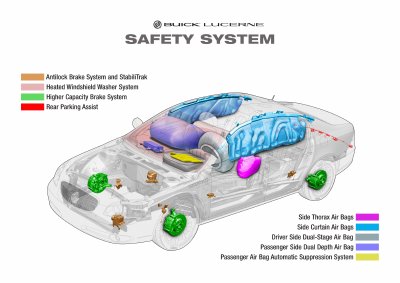
.
February
09, 2005
.
This Week:
-
Mercedes-Benz E 200 NGT: The most powerful natural-gas-driven saloon ever
-
Porsche 911 Carrera / Carrera S Cabriolet - Driving Pleasure Times Two
-
2006 Mercury Mariner Hybrid Has It All: Style, Handling, Versatility, Eco-Friendly Powertrain
-
Nissan Announces Pricing on All-New Second Generation 2005 Xterra SUV
© 1998 - 2005
Copyright &
Disclaimer
Automotive Intelligence,
www.autointell.com
All Rights Reserved .
For questions please contact
editor@autointell.net
.
GM Unveils Industry-First Dual Depth Frontal Air Bag
-
Technology tailors front-seat passenger restraint
-
Dual Depth Frontal Air Bag Animation

Photo: GM
|
Chicago - General Motors today introduced the industry's first passenger-side frontal air bag that customizes restraint by deploying in two different sizes and at different pressures, depending on seat position, safety belt usage and crash severity. GM's dual depth air bag technology will debut on the 2006 Buick Lucerne and 2006 Cadillac DTS, which were unveiled at the Chicago Auto Show. Including the dual depth bag, six air bags are standard on each vehicle. |
|
The dual depth air bag represents the next generation of air bag technology because of its potential to help restrain front-seat passengers in a greater variety of seating and crash situations. A conventional dual-stage air bag inflates to a single shape with different pressures.
The dual depth air bag deploys from the front passenger side within the instrument panel. When the small air bag is required, a tether holds the air bag back to the smaller size, and gas is vented from the module housing. For the larger air bag deployment, the tether is released, the module-housing vent is shut off, and the air bag is allowed to expand to its full size.
The dual depth air bag is the latest technology in support of GM's commitment to passenger safety. GM recently announced a commitment to make electronic stability control and the OnStar safety and security system standard on every retail vehicle sold in the U.S. and Canada, except for some commercial trucks.
Advanced sensor technology is an integral part of GM's dual depth air bag system. Using, among other indicators, a seat-position switch located in the seat track, the vehicle's Sensing Diagnostic Module (SDM) takes only milliseconds to determine the shape of the air bag to deploy.
In addition to the industry debut of the dual depth air bag, both the Lucerne and DTS will feature GM's front passenger occupant detection system, which disables the air bag if a child or smaller person is sensed sitting on the passenger seat.
In 2002, GM was the first automaker to offer passenger seat occupant detection, which features an indicator that lets the driver and passenger know whether the air bag is on or off.
Despite the evolution of advanced air bag systems, GM continues to recommend that children 12 and under ride in the rear seat, properly restrained.
(Feb 09, 2005)
| .
Homepage News Companies Management Publications Events Guestbook Search . |